Despite whatever lamentations are made about the “incompleteness” of the fossil record, fossils are actually quite common. This truism is brought home even more so whenever trace fossils – tracks, burrows, and other evidence of organismal behavior – are included in a fossil checklist (as well they should be) when examining any given outcrop of sedimentary rocks formed in the past 550 million years or so.
For example, many a time I have visited an outcrop described previously as “lacking fossils,” and instead found it filled with trace fossils; hence what people meant was “lacking fossils” equals “no body fossils.” Normally these trace fossils are invertebrate burrows, which might be glibly identified as “worm burrows,” but tracks or other trace fossils may also reveal themselves to those who are looking for them. Indeed, this expectation of finding fossils is such that on occasions when geologists find a sedimentary rock layer devoid of either body or trace fossils, this is odd enough to cause geologists to scratch their heads and ask why.
But how do the former bodily remains of plants or animals, or traces of their behaviors, become preserved as fossils in the first place? This question other related ones are answered by the science of taphonomy. Coined by Russian paleontologist Ivan Yefremov, the etymology of this term stems from Greek, in which taphos ( = burial) and nomos (= law). In such a term, he was thus alluding to an expectation that natural processes that result in fossils becoming preserved are orderly and predictable.
An overview of taphonomy as a field of study would be far too lengthy to explore here, so instead I will use one example from the Georgia coast to show how it is supposed to work. This superb case in point is a relict marsh. It is what’s left of a salt marsh from about 500 years ago, and it has been revealing its nature to paleontologists, geologists, and students for the past few decades.
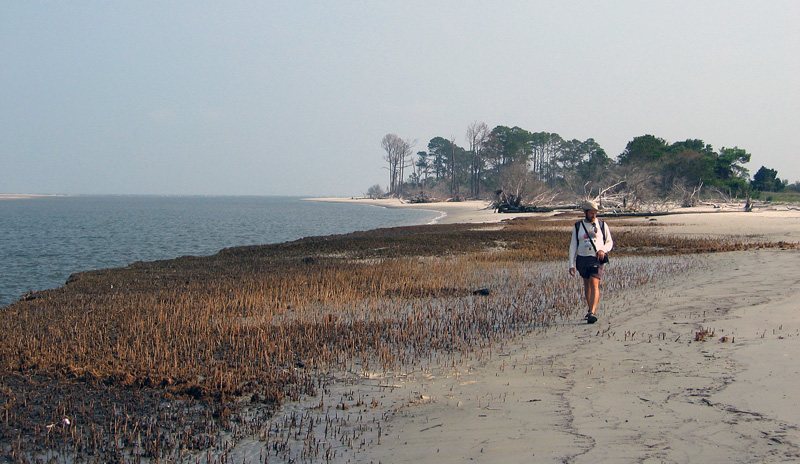 Overall view of relict marsh exposed on Cabretta Beach, Sapelo Island, Georgia. Me for scale, but photo taken 7 years ago, so the scale might now be slightly wider now. (Photograph taken by Ruth Schowalter.)
Overall view of relict marsh exposed on Cabretta Beach, Sapelo Island, Georgia. Me for scale, but photo taken 7 years ago, so the scale might now be slightly wider now. (Photograph taken by Ruth Schowalter.)
Just a little more than a week ago, my colleague Steve Henderson and I took a group of students from Emory University to Sapelo Island for a weekend field trip (detailed last week). One of our goals on this trip was to take them to a relict marsh on Cabretta Beach so that they could better appreciate how a sedimentary deposit makes a transition from living ecosystem to inert rock, yet filled with evidence of its formerly teeming life. Similar relict marshes are on St. Catherines Island and other Georgia-coast islands, but when it comes to teaching about taphonomy in the field, I prefer using the one on Sapelo.
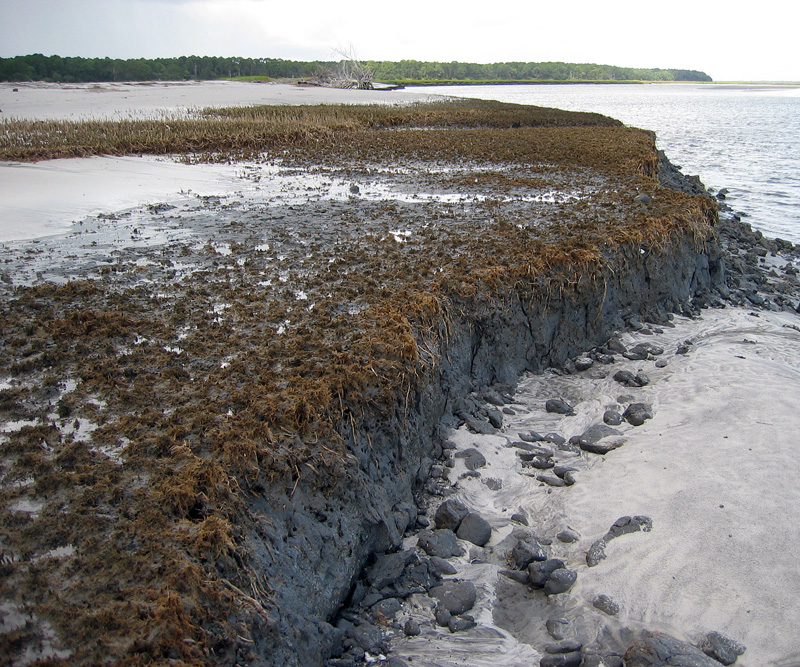 Closer view of relict marsh on Sapelo Island, showing 500-year-old remains of smooth cordgrass (Spartina alterniflora), cross section of its muddy sediments, and quartz sand deposited on top by tides, waves, and wind. (Photograph by Anthony Martin.)
Closer view of relict marsh on Sapelo Island, showing 500-year-old remains of smooth cordgrass (Spartina alterniflora), cross section of its muddy sediments, and quartz sand deposited on top by tides, waves, and wind. (Photograph by Anthony Martin.)
As mentioned in a previous entry, modern salt marsh on the Georgia coast have a few key components that make them among the most productive of all ecosystems: smooth cordgrass (Spartina alterniflora), marsh periwinkles (Littoraria irrorata), mud fiddler crabs (Uca pugnax), and ribbed mussels (Geukensia demissa). So if a Georgia salt marsh were to be buried quickly – say, by a storm that dumps a thick layer of sand on it – what would be preserved? The Cabretta relict marsh partially answers that question, showing us incipient trace and body fossils of these biota. They are not quite fossils, but on their way there, giving us a glimpse of the fossilization process well before it is completed.
For example, the tall, green or golden stalks of smooth cordgrass that we see today, adorned my millions of marsh periwinkles (Littoraria irrorata), are absent from the relict marsh. Only the lowermost ochre-colored stubs and extensive root systems remain, and traces made by the roots below what was the marsh surface.
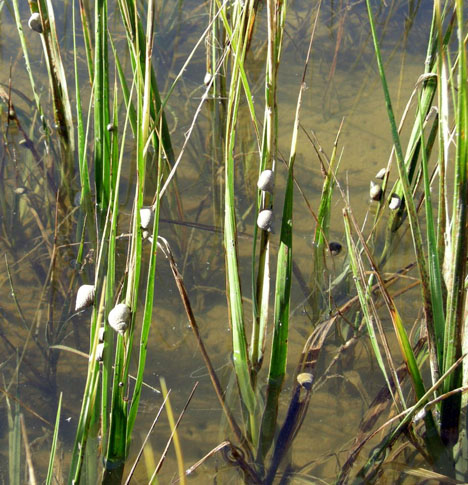 Modern smooth cordgrass (Spartina alterniflora) and its constant companions, marsh periwinkles (Littoraria irrorata) on Sapelo Island, Georgia.
Modern smooth cordgrass (Spartina alterniflora) and its constant companions, marsh periwinkles (Littoraria irrorata) on Sapelo Island, Georgia.
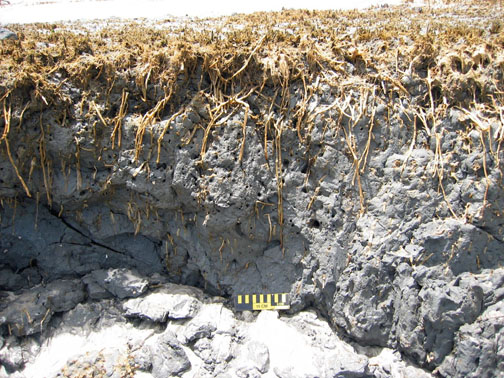 Cross-sectional view of relict marsh, what is left from a formerly magnificent marsh: stubs, roots, root traces, and not many periwinkles. (Both photographs by Anthony Martin.)
Cross-sectional view of relict marsh, what is left from a formerly magnificent marsh: stubs, roots, root traces, and not many periwinkles. (Both photographs by Anthony Martin.)
Once in a while, I also find old marsh periwinkle shells scattered on the surface of the relict marsh. These are made of calcium carbonate and will dissolve in slightly acidic waters, so these might not last for long once exposed. The real reason for why these tend to disappear quickly, though, is modern hermit crabs. Hermit crabs encounter these periwinkle shells on the relict marsh surface, say “Hey, free shells!”, then happily trot away with these, not caring that their “new” homes are actually 500 years old.
No mud-fiddler crab remains were apparent on the surface, nor have I seen them in 20-30 visits to this relict marsh. This is not surprising, as their exoskeletons are made of chitin and dissolve more quickly than molluscan shells. Nonetheless, their burrows are always abundantly evident on the surface as perfectly round holes, which are sometimes accompanied by new burrows made by modern fiddler crabs, as well as bivalves that will bore into this firmground.
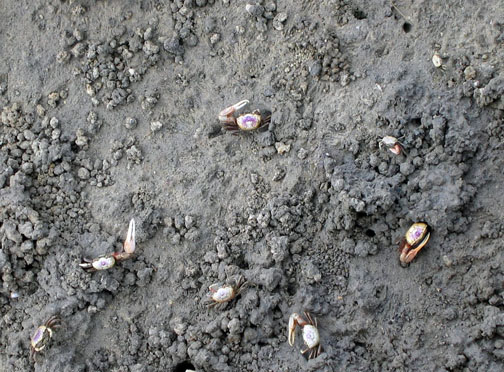 Modern salt marsh surface on Sapelo Island with mud fiddler crabs (Uca pugnax) showing off a few of the behavioral traits they do best: eating, fighting, mating, and burrowing. Note that burrows, surface scrapings, and pellets are a few of the traces they make. Which of these traces get preserved?
Modern salt marsh surface on Sapelo Island with mud fiddler crabs (Uca pugnax) showing off a few of the behavioral traits they do best: eating, fighting, mating, and burrowing. Note that burrows, surface scrapings, and pellets are a few of the traces they make. Which of these traces get preserved?
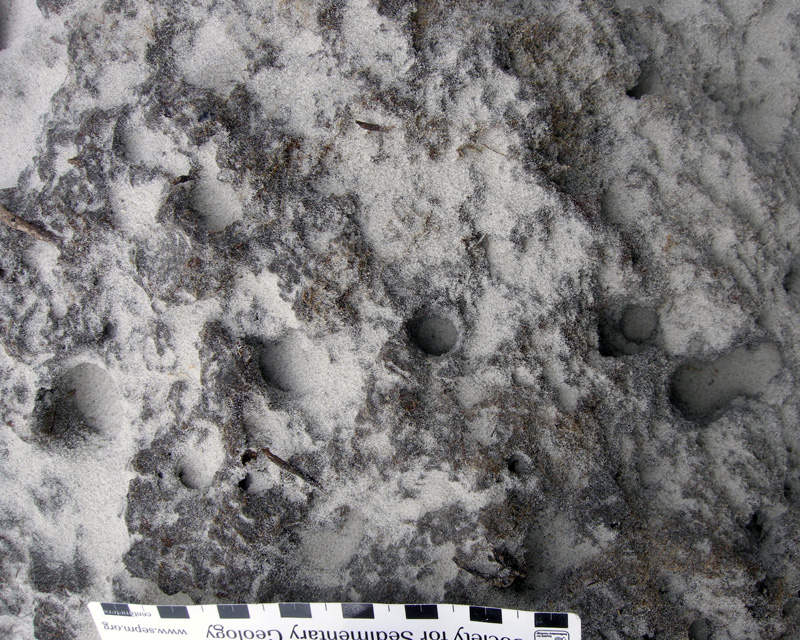
Close-up of eroded relict marsh surface, showing cross-sections of old fiddler-crab burrows now being filled with modern beach sand. Think of how this will look in the fossil record. (Scale in centimeters).
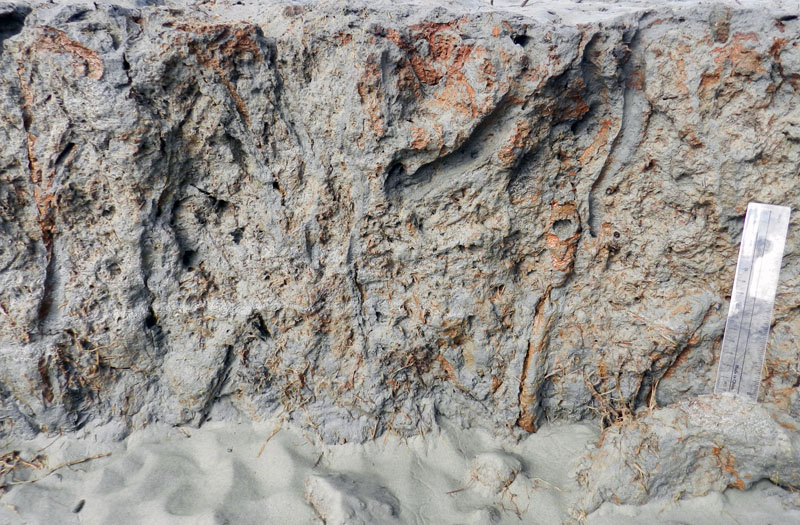 Longitudinal view of former fiddler-crab burrows associated with smooth-cordgrass root traces. Fill the deeper parts of these burrows with sand, and they’re more likely to get preserved as trace fossils. Scale to right is 15 cm (6 in) long. (All photographs by Anthony Martin.)
Longitudinal view of former fiddler-crab burrows associated with smooth-cordgrass root traces. Fill the deeper parts of these burrows with sand, and they’re more likely to get preserved as trace fossils. Scale to right is 15 cm (6 in) long. (All photographs by Anthony Martin.)
Modern ribbed mussels are harder for us to see in the field because we would have to wade into soft, deep, sulfurous mud to get close to them, and however amusing that might be, we don’t have time to do our laundry before getting back into our rental vans for the ride home. So the students take our word for it that those mussels are indeed in the marsh, then we point to the old ones clumped on the relict-marsh surface that are still in life position.
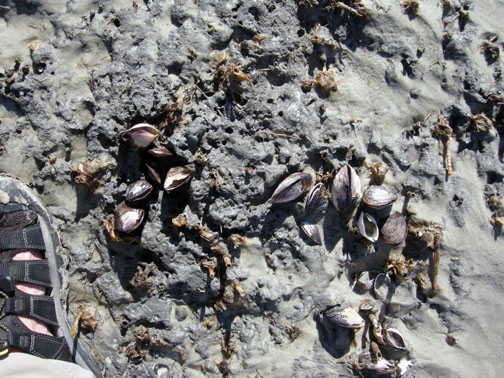 Cluster of ribbed mussels (Guekensia demissa) directly associated with stubs of smooth cordgrass on relict marsh surface. Now that they’re exposed, how long will these shells last on the surface? (Photograph by Anthony Martin.)
Cluster of ribbed mussels (Guekensia demissa) directly associated with stubs of smooth cordgrass on relict marsh surface. Now that they’re exposed, how long will these shells last on the surface? (Photograph by Anthony Martin.)
Oysters (Crassostrea virginica) are less common in the relict marsh, but given the right exposure, these can be observed on some visits too. These clumps of oyster shells mark the edges of tidal creeks that wound through the marsh.
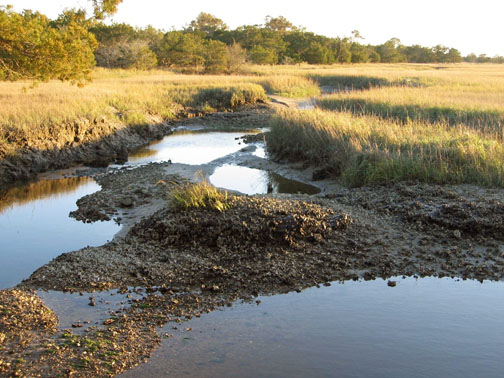 (Top) Modern salt marsh with tidal creek cutting through it and oyster bank exposed at low tide, Sapelo Island.
(Top) Modern salt marsh with tidal creek cutting through it and oyster bank exposed at low tide, Sapelo Island.
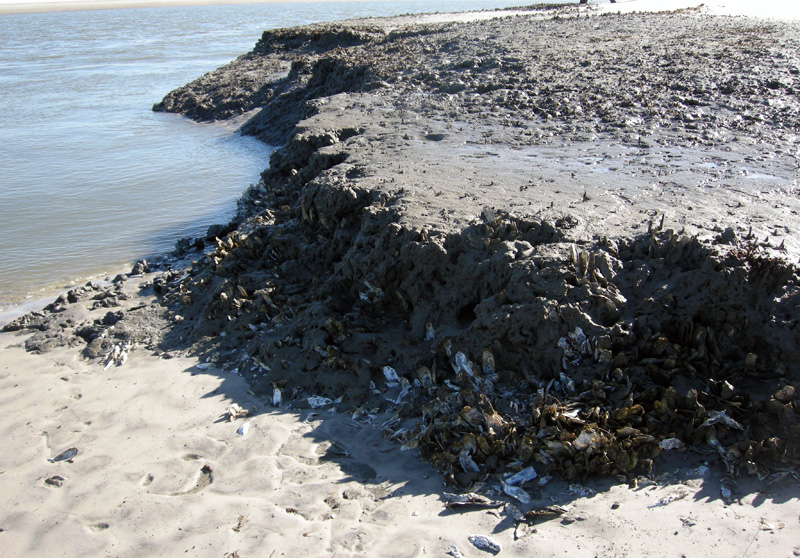 Former oyster bank peeking out of relict marsh, formerly buried for about 500 years, now revealed by erosion of the modern shoreline. (Both photographs by Anthony Martin.)
Former oyster bank peeking out of relict marsh, formerly buried for about 500 years, now revealed by erosion of the modern shoreline. (Both photographs by Anthony Martin.)
Because it was all too easy to spot the similarities between this relict marsh and a modern one less than 100 meters (330 feet) from where we stood, I then asked about other differences. For instance, take the fact that we were standing on the relict marsh while discussing its traits: could we do the same in the modern marsh nearby? No, was the universal answer, and I affirmed that they would likely be up to their waists in ribbed-mussel-produced mud. (I asked for volunteers to test this hypothesis, and they very smartly declined.)
This led to a discussion of why the relict marsh could be so firm, which introduced them to the concept of diagenesis: how a sedimentary deposit can change over time, an important consideration in taphonomy. Such alterations are especially apparent in muds, which lose considerable volume as these lose their water content, causing a “softground” to become a “firmground,” then eventually a “hardground.” The students were surprised when I told them that the relict marsh acting as the floor of our “classroom” was likely 2-3 times as thick as what was there now.
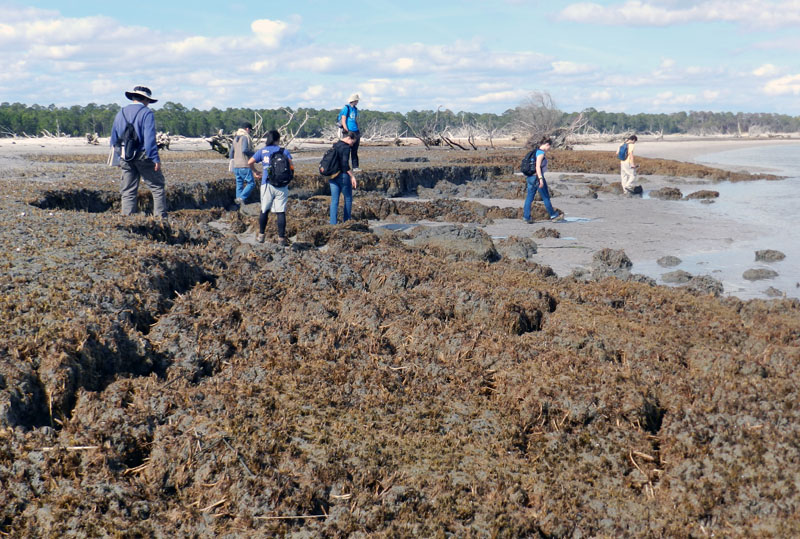 Would these students so blithely walk around on a modern salt marsh? I don’t think so, and please don’t experiment with this yourself. Nevertheless, a relict marsh, thanks to dehydration of its muds and compaction, is just fine for exploring on foot. (Photograph by Anthony Martin.)
Would these students so blithely walk around on a modern salt marsh? I don’t think so, and please don’t experiment with this yourself. Nevertheless, a relict marsh, thanks to dehydration of its muds and compaction, is just fine for exploring on foot. (Photograph by Anthony Martin.)
We spent only about an hour at the relict marsh before regretfully walking back to our field vehicle, followed by a ferry ride to the mainland part of Georgia and a long drive home to Atlanta. Yet I felt assured that the lessons about taphonomy, ancient environments, ichnology, and diagenesis imparted by this relict marsh encompassed enough material to fill 4-5 class sessions in an indoor classroom. Moreover, if we had been all enclosed by four walls and a ceiling, and without a former marsh underfoot, there was no guarantee that these concepts would be understood or retained.
This is why we geoscientist-educators take our students outside, enriching our collective awareness of how environments change through time and how we piece together the clues left behind from ancient environments. It’s memorable, it’s fun, and it works. But don’t take my word for it. Whether you’re an educator or student, try it yourself sometime, whether on the Georgia coast or elsewhere, and see what happens.
Further Reading
Basan, P.B., and Frey, R.W. 1977. Actual-palaeontology and neoichnology of salt marshes near Sapelo Island, Georgia. In Crimes, T.P., and Harper, J.C. (editors), Trace Fossils 2. Liverpool, Seel House Press: 41-70.
Edwards, J.M. and Frey, R.W. 1977. Substrate characteristics within a Holocene salt marsh, Sapelo Island, Georgia. Senckenbergiana Maritima, 9: 215-259.
Frey, R.W. and P.B. Basan. 1981. Taphonomy of relict Holocene salt marsh deposits, Cabretta Island, Georgia. Senckenbergiana Maritima, 13: 111-155.
Frey, R.W., Basan, P.B. and Scott, R.M. 1973. Techniques for sampling salt marsh benthos and burrows. American Midland Naturalist, 89: 228-234.
Letzsch, W.S. and Frey, R.W. 1980. Deposition and erosion in a Holocene salt marsh, Sapelo Island, Georgia. Journal of Sedimentary Research, 50: 529-542.
Morris, R. W. and H. B. Rollins. 1977. Observations on intertidal organism associations on St. Catherines Island, Georgia. I. General description and paleoecological implications. Bulletin of the American Museum of Natural History, 159: 87-128.
Smith, J.M., and Frey, R.W. 1985. Biodeposition by the ribbed mussel Geukensia demissa in a salt marsh, Sapelo Island, Georgia. Journal of Sedimentary Research, 55: 817-825.

You explain aspects of the coast so well! Your blog entries definitely require a second and third read to take in all of the information. At the same time, I find it so easy to read. Thank you for taking the time to craft these explanations about our Georgia barrier islands, and in this case–Sapelo’s relict marsh!
Thanks for the new ” term”, I’ve apparently been studying relic lagoons and relic deltas from the Mesozoic for the last ten years. As mentioned in the diagenesis process, I’ve found an abundance of organic fossil remains, from micro to body fossil and have concluded that the final destinations of all the bits and pieces of former life were salt brined, initially, and then turned into hard bedrock. Points of land and reefs are the types resiliency that remains as “relic”lagoons and deltas.